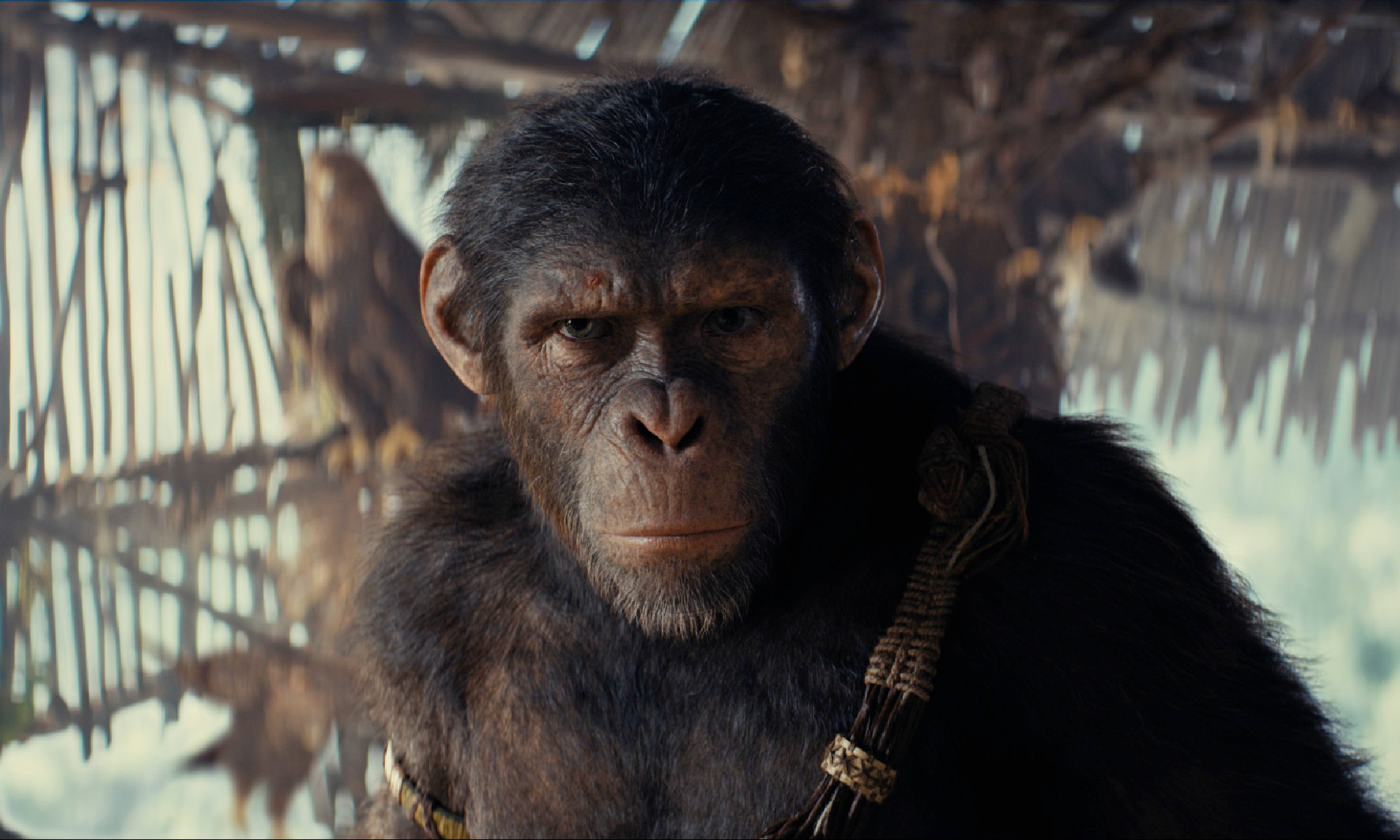
Kingdom of the Planet of the Apes, the 10th and latest entry in the 56-year-old science fiction film series, made more than $58 million at the box office in its opening weekend. Not only did the movie exceed analysts’ expectations but it proved that seven years after the previous film in the cycle, and nearly six decades since the whole barrel of monkeys started, there is still an audience out there for this venerable and fascinating concept.
Which is all the more impressive when you consider how much of a unicorn this series is among the various stories, brands, and “intellectual property” revisited time and again by modern film studios. Whereas other franchises are eager at constantly revisiting their pasts, the Apes movies have proved remarkably elastic in stretching their concepts in the direction of new ideas and stories. There is of course some pushback by fans. A brief perusal of any forum or Planet of the Apes Facebook group, for instance, will find a smattering of devotees indignant about the new movies, and insisting they will not even watch the latest film after being disappointed by the overall excellent 2010s Apes trilogy starring Andy Serkis—this critique is apparently based on the films no longer using the 60-year-old makeup designs from the original movie in favor of CGI motion-capture.
This is of course nonsense. We love the original films wholeheartedly—this author’s earliest movie memory is seeing Beneath the Planet of the Apes in a drive-in, wearing pajamas in the back seat of my mom’s car—and we revere 1968’s Planet of the Apes as the all-time genre milestone that it is. The makeup effects devised for the humans playing apes were pioneering for their time. But there’s also no question that the four original sequels are riddled with flaws and plot holes (just how did Dr. Milo get that ship out of the water?), and that their decreasing budgets and care are evident in some of the skimpiness of the visuals and sets.
But what is impressive is how uniquely liberated the Apes franchise has been from bowing to such perceived fan grievances. Discounting Tim Burton’s soulless 2001 remake (which did, to be fair, feature some incredible ape prosthetics by the great Rick Baker), the rebooted trilogy of the 2010s (2011’s Rise of the Planet of the Apes, 2014’s Dawn of the Planet of the Apes, and 2017’s War for the Planet of the Apes) was not just a surprisingly respectful continuation of the series, but both critically acclaimed and stunningly groundbreaking in their use of performance capture technology to create ape characters performed by human actors that were among the most realistic digital creations ever committed to film.
This is where the Apes franchise succeeds and how it finds new audiences while other classic sci-fi properties like Star Wars and Star Trek—while successful in their own right—cannot break out of their respective fan bases and find ways to entice and impress new fans.
Reinvention of the Planet of the Apes
The first five Apes movies were not just trailblazing in their use of special effects makeup but also in their narrative conceit: the quintet of films told one continuous story that spanned thousands of years and circled back on itself, spinning a future history of Earth that was not only laid out on a grand scale but was also surprisingly bleak and often nihilistic for mainstream Hollywood-produced cinema (and all but one of them was rated “G,” no less).
While the 2001 Burton remake had its strong points (the makeup, the score, some of the individual performances), it was hampered by a miscast leading man, an incoherent script (the result of a couple of decades of inept development that simply tried to fit the Apes concept into a generic action-movie premise), and the sense that it wasn’t about anything but cashing in on (at the time) a dormant property with a fresh coat of paint and some gaudy directorial pizzazz. Plus it was essentially a remake of the original film: astronaut travels into the future, finds himself on planet of intelligent apes, must escape. Yet it had none of the subtle satire or sociological underpinnings of the original in which Charlton Heston’s Col. George Taylor finds himself defending the human race after fleeing to space to get away from everyone in the first place.
So somebody at 20th Century Fox (the studio home of the apes before it was absorbed by Disney) must have taken a lesson from this, because the next iteration of the cycle, beginning in 2011 with Rupert Wyatt’s Rise of the Planet of the Apes, took a different tack completely. For one thing, the idea of putting human actors in prosthetics was over; CGI and performance capture technology, moving forward in leaps and bounds, would allow for the very look and feel of the apes to be reimagined. Secondly, this era of the franchise would focus from the beginning on the apes. While the original cycle had brilliantly tilted the point of view from human to ape over the course of the five films (with 1971’s Escape from the Planet of the Apes being the pivotal title), Rise of the Planet of the Apes centered itself from the beginning on the ape known as Caesar, the unassuming laboratory chimp (performed indelibly by Andy Serkis), who over the course of the movie would become both a scientifically enhanced version of himself and a revolutionary leader of his people.
Yes, in the bare bones of it all, Rise and its follow-up, 2017’s Matt Reeves-directed Dawn of the Planet of the Apes, loosely reinterpreted some of the events of the later films in the original cycle, 1972’s Conquest of the Planet of the Apes and 1973’s Battle for the Planet of the Apes. There were even easter eggs giving the nod to the original series, such as Caesar’s name itself and news reports of a spacecraft launch that was unquestionably supposed to make us wonder if Col. Taylor was commanding the ship.
But the origin of the apes, how they became intelligent while humankind fell, and how Caesar evolved from a wartime leader into a Moses-like figure leading his tribe to the promised land, was all different. The characters were all different. The trajectory of the story was altered too. And unlike the 2001 entry, the Caesar trilogy was about many things, some of which are continued in the new film: hubris, greed, indifference, and cruelty to other forms of life, and the ever-relevant question of whether two competing species can tolerate each other’s existence. Many fans debate online about whether the current Apes cycle, which now includes Kingdom ,is part of the same continuity as the original films. Our theory is that they’re not: we believe they take place in a parallel universe, much like the Spider-Verse in some ways, where certain major turning points in history remain constant, even as the details around them change.
The Future of the Planet of the Apes
The point is this though: it would have been relatively easy to just try again and straight-up remake the original films, even using modern technology to bring beloved characters like Cornelius, Zira, and Dr. Zaius back into the fold. The studio, producers, and filmmakers could have just traded on nostalgia and past glories and probably done okay at the box office.
But they haven’t. Unlike Star Wars or Star Trek (or Marvel, for that matter), you can pretty much walk into Rise of the Planet of the Apes and start watching from there, without ever having to watch the original five films. Don’t get the wrong idea: Planet of the Apes is ingrained in pop culture and the title itself will absolutely bring people in. But there’s no homework to do, no catching up, no references that one must understand to proceed with the current story. There may be a whole generation of viewers now who watch the current cycle without ever having seen the originals.
The next Star Wars movie will probably require you to watch three seasons of an already existing TV series, possibly along with parts of others. You don’t have to know anything about the older Apes movies to enjoy the current series, although of course if you are a diehard fan, your enjoyment will be enhanced by your knowledge of the overall franchise. Even Kingdom doesn’t just pick up where War for the Planet of the Apes left off: instead of following the adventures of Caesar’s clan after his death at the end of that film, the new movie hurtles us a few hundred years into the future—an era that actually has had no screen counterpart to date as the series begins exploring the conflicts between different ape tribes.
We’re pretty sure that if the current cycle continues, we’ll begin to see more familiar aspects of the Apes history come into view, although we might also see elements of that history never before shown in a movie. Director Wes Ball told Den of Geek that he’d like to see when the Statue of Liberty got buried in radioactive sand or how the Sacred Scrolls came into being. There’s a danger in that, of course, and the very real possibility that the talent behind these films might finally give in and just lead us right into a remake of Planet of the Apes as the timeline finally gets to that point.
But in the meantime, Kingdom has given us a new story, one where the hero of the previous set of films is now nothing but a legend and where ape civilization may struggle with the same problems that keep sending the human race to the knife’s edge of oblivion. Just as the original Planet of the Apes helped usher in an age where science fiction was finally taken seriously as a film genre, the current era of the franchise proves that you don’t have to give audiences the same thing over and over again. Despite what some negative nellies might say online, the Apes franchise has created entire new generations of fans by embracing the new and walking beyond the familiar, well-trodden paths. The original films will always be there, and so will the new ones. As Caesar himself said, apes together strong.
Kingdom of the Planet of the Apes is in theaters now.
The post Planet of the Apes: The One Sci-Fi Franchise That Successfully Moves Forward appeared first on Den of Geek.







